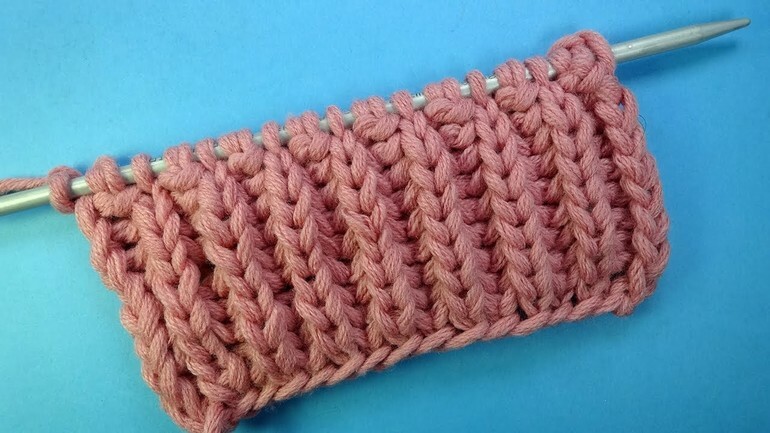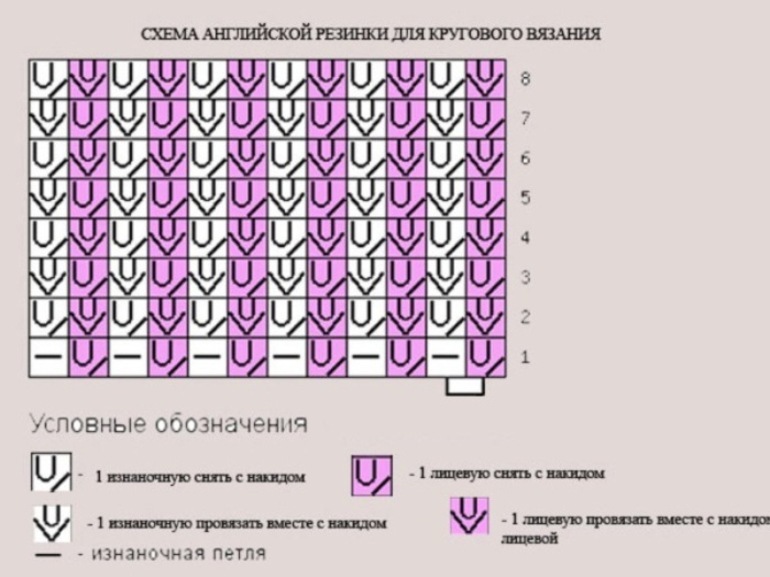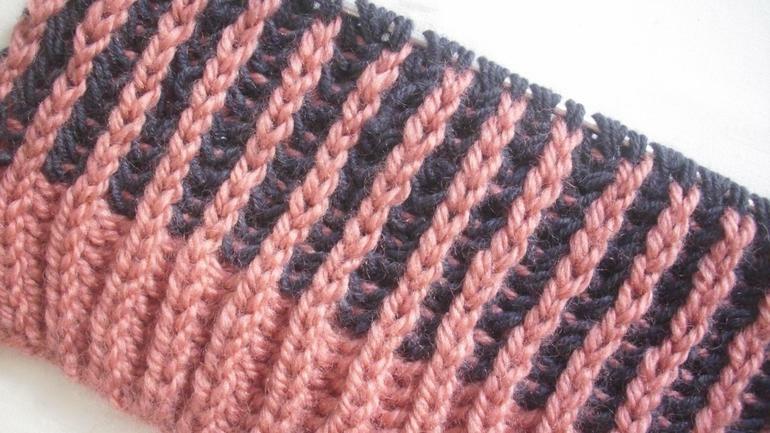Modern clothes are comfortable and practical, but very similar. Thanks to the art of hand knitting, you can create your own unique things. Before we study the knitting pattern of the English gum with knitting needles for beginners, let's get acquainted with this type of knitting. This simple pattern is available to all beginners to learn the basics of knitting.

In the autumn and winter cold, it is pleasant to put on a cozy scarf, a lovely hat or other stylish pieces of clothing - sweaters, jackets, vests, stoles. All these wonderful things can be done by hand. To do this, you just need to master the "English elastic" pattern. Soft and airy, this knit is suitable for any garment. After mastering the English gum, you can look for others knitting patterns with patterns.
Content
- Basic information
- Rules for working with a pattern
- Types of equipment
- Main circuits
- The classic way
- False gum
- Dual English
- Volumetric two-tone
- Use in products
Basic information
This knit is a double-sided fabric that looks great from both the front and back sides. Such knitting differs from the usual smooth surface with a pronounced relief, because it has a well-visible scar. It looks like a pigtail in the center of the piece, giving the thing an interesting look. The product made with this pattern perfectly stretches both in width and length.
Rules for working with a pattern
Despite the sufficient simplicity of this type of knitting, in the process of work, some questions and complications may arise. Therefore, it is recommended to use the tips:

- It should be borne in mind that when using a double knitting technique (knitting with crochets), the yarn consumption also increases by one and a half to two times from the usual one.
- To get the pattern even and smooth on both sides, the front ones are always knitted behind the front wall, and the back ones - behind the back.
- Before applying the pattern to the product, it is advisable to knit the pattern. Knit it with the same threads from which you will knit the product. The density of the web is visually uneven. Therefore, there is a risk that the sweater will turn out to be huge in width or highly stretched in length.
- To make the pattern look complete, dial the number of loops that will be a multiple of three.
- Knitting needles are chosen a little thicker than the threads.
- This type of knitting is not at all suitable for finishing the necklines and cuffs of products, as it stretches a lot, with the exception of children's clothes.
- It is better to dry a knitted item by spreading it out on a table or other horizontal surface. Otherwise, the thing is deformed.
- Keep in mind that, thanks to the embossed structure, this knit emphasizes figure flaws.
- The thicker the knitting needles and yarn, the more voluminous and lush the knitting.
Types of equipment
There are many varieties of such a simple pattern. The main ones are:

- Classic or 1/1.
- False.
- Difficult or 2/2.
- Faceted.
- Lush.
- Two-tone.
- Semi-English.
And that's not all. With some skill, you can easily vary the number of purl and front in the pattern and get different options.
Main circuits
The most commonly used are common, double, and false views. Before reading the instructions for beginners and knitting an English gum with knitting needles, you need to understand and master some terms:

- The first edge is to remove without knitting.
- The last edge is purl.
- Crochet - a working thread is put on the end of the right knitting needle. You need to grab it to yourself, that is, from right to left. This type of nakida is also called straight.
- Two loops are knitted together like this: a knitting needle is inserted into both loops from the front and a working thread is pulled through them.
- For convenience, the names of the loops are abbreviated. Front loop - lp, purl loop - SP.
An important clarification. In the description of all patterns of patterns, there is a mention of edge loops. But if you are going to knit a scarf or any other seamless item, it is best not to do the hem. Then the edge of the thing will look beautiful.
The classic way
It is better to start learning knitting with the classic version of the one-on-one elastic pattern. No wonder this type of gum is the main one. One has only to get involved in the work and get used to pulling all the loops of the same length, and you will see how beautiful your work will look. Here are instructions for beginners on how to knit an elastic band. Type the required number of loops on the knitting needles (it is better to take an odd number if you need to get an even edge of the canvas and ensure its beauty on both sides) and knit like this:

- The first row is one lp, then the thread is thrown over the knitting needle towards itself (this will be the so-called yarn), the next loop is removed, knitted like this until the end of the row.
- The second row is knitted in this way: first yarn over. Together with it, the SP is removed, and the yarn with the removed loop of the previous row is knitted together with the LP. You need to alternate this sequence.
- In the third row, the loop and yarn of the last row are made lp, yarn, the next sp is taken on the right knitting needle, without knitting. Do not forget about the initial and final edging.
- Further, the pattern is performed by alternating the second and third rows.
False gum
For beginners, the scheme of English knitting with knitting needles who have not yet mastered the concept of "yarn", we can recommend first mastering a false (fake) elastic band. This method is also suitable if you need to save yarn. Despite the extreme simplicity of execution, surprisingly chic things can be knitted with such a pattern. Both jumpers for mature men and cropped youth blouses will look stylish and elegant.

Try it and see for yourself how elementary the simple scheme of this pattern is. First you need to dial on the knitting needles the number of loops, a multiple of four, plus two more. In the first row, you need to tie alternately 3 lp, 1 un. The second row begins with two front ones, and then one purl should be alternated with three front ones. You need to remember about edging. Repeat the pattern from the first row.
Dual English
After mastering the false and classic elastic, you can move on to more complex and interesting ways of knitting. For example, try to make a thing with a double (complex) elastic band pattern.
Instructions for beginners on how to knit an English elastic with knitting needles in the 2/2 version:

- We collect loops in the same amount as for false knitting.
- In the first row we perform two LPs, alternating with two SPs. We finish with two front ones.
- We start the second row with a crochet, remove two without knitting, two lp. We repeat. With the crochet and the last two removed loops, we complete the row.
- In the third row, grab the yarn and loop of the bottom row and make a lp, remove the yarn and two loops. At the end, we knit the penultimate loop with a crochet and the last one is made lp.
- The fourth row - we remove, without knitting, a yarn with two lp, the next loop will be knitted together with a yarn lp, then again lp.
- We continue knitting, alternating the third and fourth rows.
Volumetric two-tone

This is another variation of this pattern that you should try to learn how to knit. It will look quite interesting when using contrasting colors or shades of the same color. In the first case, an amazing combination is obtained, especially suitable for bright children's or stylish youth products. In the second version, you will get an exquisite thing with delicate tints of the canvas. If you have time and patience, you can try using several tones of the same color and soon a unique thing is guaranteed to delight your eye.
The peculiarity of working with a two-color elastic band is that the same row is knitted as if twice. Once with a thread of the color chosen for the base, and the second time with a thread of an additional color. And one more thing, which is very important not to forget when knitting with this pattern: each time the fabric is turned by the side where the thread of the color required for this row is located.
It is very important when knitting products with an English elastic band to properly close, subtract and add loops.

- Subtracting. We begin to knit three loops together. This method will not disturb the elastic loop sequence. And on the right we knit like this: we remove the first as in knitting, we knit the second and third together and we pass the first loop through it. On the left, everything is much simpler - three LPs together.
- Adding. To smoothly knit additional rows into the main pattern, we begin to add loops in every sixth row, one loop on each side.
- Closing. Since when knitting this pattern on the needles, more loops are always obtained than at the beginning due to yarns, it must be finished correctly. So that the upper edge of the product, knitted with an English elastic band, looks neat and does not stretch, you can do this: knit the last row with a regular cutter, and only after that close the loops as usual way.
Use in products
Everyone wants a hand-knitted thing to look good and delight the eye for a long time.. To do this, when knitting, it is useful to take into account some of the nuances:

- When knitting a scarf, it is better to dial more loops on the knitting needles. In this way, it will turn out to knit a short, but wide scarf. In the process of wearing, it will certainly stretch out.
- When knitting berets or hats (no matter, on circular or straight knitting needles), it is better to start with a regular elastic band. In this case, a simple 1/1 elastic will look good. This method will provide a better fit for the head. Also, there will be no problems with wearing this thing in any windy weather.
- You should not knit the backs of vests, sweaters or sweaters with this type of knitting, since even proper care of the thing and a neat sock may not save it from deformation. To prevent stretching, you can make a model of a sweater with raglan sleeves, and choose a hard yarn for knitting from natural fibers.
- The shelves of jackets will turn out to be asymmetrical if they are made with this elastic band.
- Very good knitting with an English elastic band is suitable for making stockings, leggings, bibs, mitts.
The listed tips and tricks will make the perception of patterns of patterns easy, and knitting itself - pleasant and exciting.



